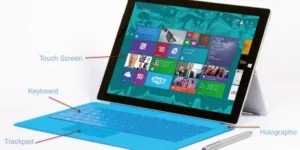The means of interface between people and computers is currently dominated by the use of a sextet of well-known devices: mice, trackpads, joy sticks, keyboards, styluses and touch screens. The latest news, however, is that Microsoft is developing an alternative means of input, one that could enable somewhat different user usage patterns.

The starting point for the new approach reportedly derives from aspects of the user experience associated with the company’s HoloLens HMD. It seems Microsoft’s intention is to apply learnings from this technology to future generations of their Surface devices….and to do so in a way that does not require the user to wear glasses. The new approach is disclosed in a recently published patent application that describes means to produce a “holographic layer” that floats just over the surface of the keyboard.
The means for implementing the new interface is described generally as being comprised of a holographic recording mechanism disposed over all or part of an input device. Described more specifically, it is a transparent thin film secured over a pressure sensitive keyboard.
The medium of the film might include a silver halide photographic emulsion or photopolymer layer. In any case, the holographic recording mechanism is “configured to record the phase of an optical field of an original object in an image scene”. An LED or laser diode, included as part of the computing device (see the example of a laptop in the illustration below), is positioned such that the light it emits impacts the holographic recording mechanism and causes a three-dimensional hologram or “floating graphic” to be displayed above the keyboard.
The patent application goes on to disclose a configuration that includes multiple holographic recording mechanism layers. The hologram on each of these layers is recorded using a different and narrow wavelength band of light. This configuration can produce different imagery when illuminated by a LED or laser diode having a corresponding narrow wavelength band of light.
The holographic layer could be used to present a secondary user interface. In one implementation, the input device is configured to produce a hologram that indicates gestures and/or functions supported by the computing device. If the computer were to include near-field sensors such as a camera configured with multiple lenses, it would allow different perspectives to be captured thus allowing determination of depth.
In such a configuration, input would not require the user to physically contact the Surface. The sensor detects the position of the tip of the user’s finger and initiates an operation associated with a virtual holographic “button” when the user’s fingertip enters the volume associated with the button.
Alternately, the system could be configured to receive inputs via physical touch of the hardware underlying the hologram such as the keys of the keyboard.
In sum, the input device and controls incorporated by the input device may assume a variety of different configurations to support a variety of different functionalities.
The patent application mentions one interesting embodiment and use of the holograms. The hologram can be made to have a limited field of view. In this case, a person standing next to the user could not see the “keys” being pressed allowing the hologram to be used as a means to enhance privacy.
Microsoft filed their patent application in the fourth quarter of 2013. Nonetheless, if and when the holographic technology might be used in a product is currently uncertain. – Arthur Berman

